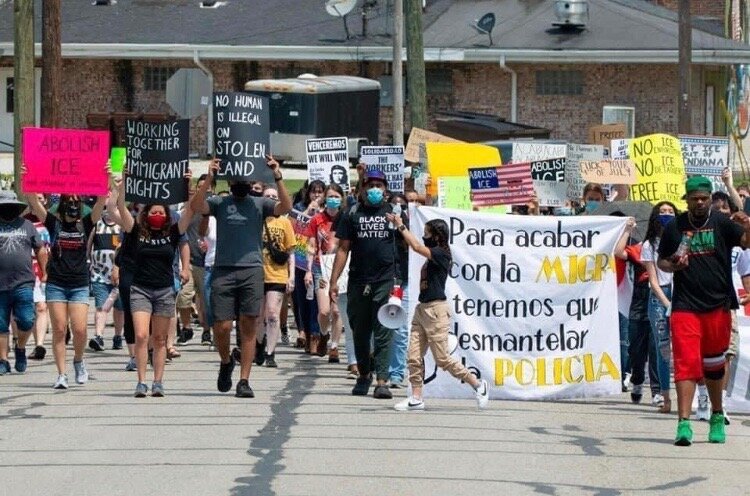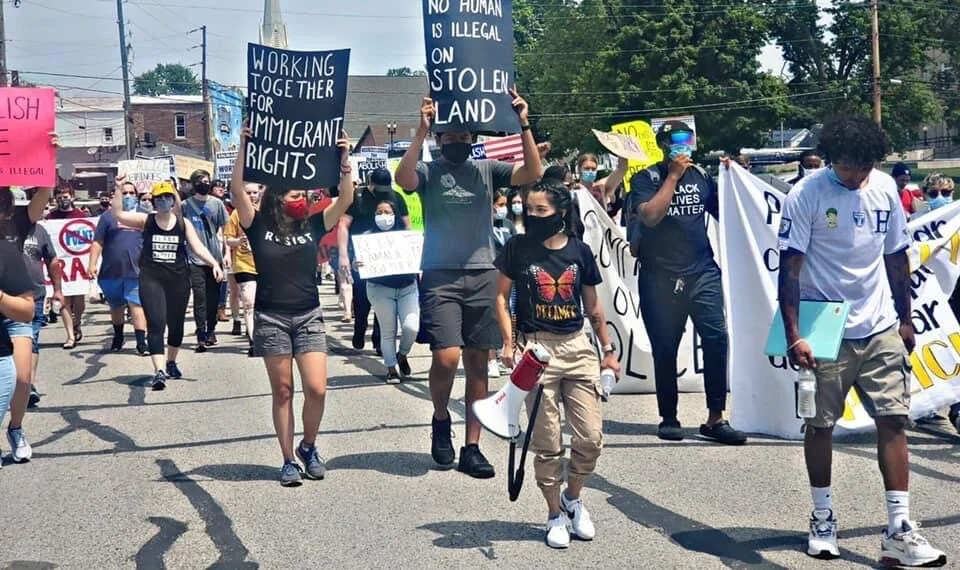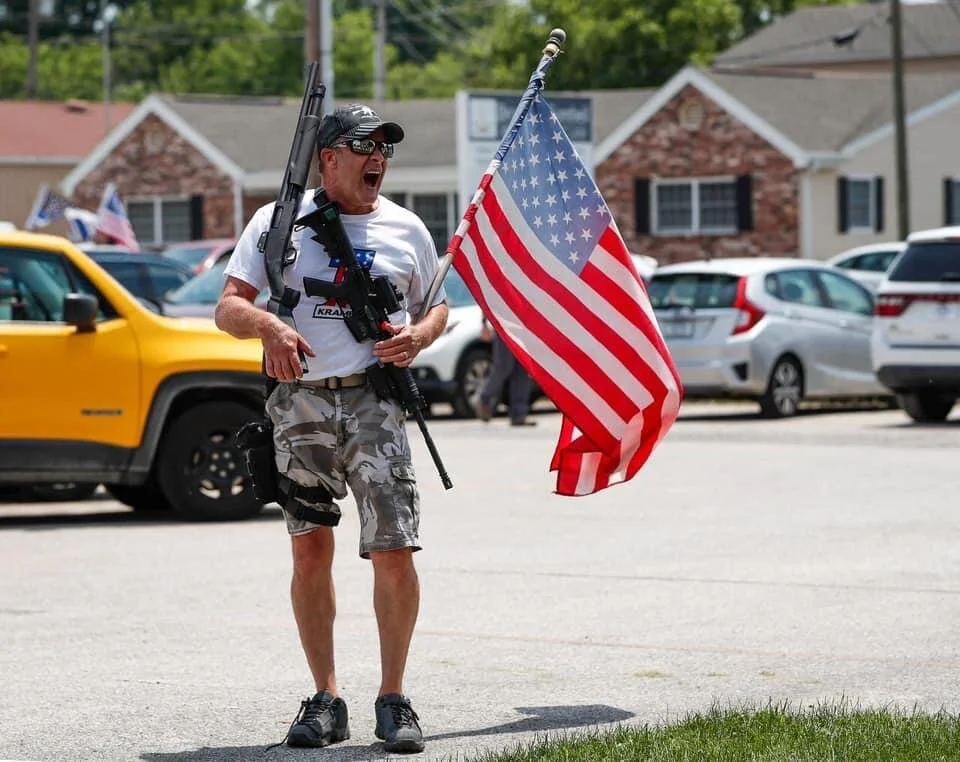How State Violence Translates to Political Action for Immigrants in the Midwest
Editor’s Note: The following essay is part of a politics dossier featuring presenters from The Latinx Project’s recent conference, “Latinx Politics — Resistance, Disruption & Power.” To download the PDF, click here.
In light of the Trump administration's persistent attacks on BIPOC communities, understanding when and how immigrants will mobilize and align themselves politically with other race-class subjugated groups is more important than ever. Individuals, moreover, can respond to traumatic experiences in different ways. Whether you have lived in the country for well over a decade or whether you have just fled violence in your home country, experiences with the U.S. immigration system are filled with uncertainty and can have long-term psychological, relational, and economic effects. Similarly, the alienating effects of police violence among the Black community are well documented and this research tells us that state violence is repetitive, cumulative, and has enduring political consequences (for more on this, see Soss and Weaver 2017 and Weaver and Prowse 2020). However, when individuals turn inwards and seek information and opportunities to challenge the state is less understood in political science.
Police killings of Black individuals and human rights abuses in immigration detention have undoubtedly heightened feelings of distrust between race-class subjugated groups and the state. But how might they affect feelings of solidarity or cooperation among targeted groups? My research with immigrants formerly detained in Immigration and Customs Enforcement (ICE) custody and their loved ones, survey data, and administrative crime reporting exposes how experiences of state violence are translated into political action. First, individual responses to state violence are more heterogeneous than the prevailing literature contends. Second, and perhaps unsurprisingly, state violence decreases voting and crime reporting. However, my study has shown that state violence increases participation in community-based forms of political action and support among immigrants for Black Lives Matter.
How has racialized state violence and COVID-19 in the U.S. affected immigrant communities?
Following the devolution of immigration policy-making from the federal to the local level, the state of Indiana has featured a particularly closed policy landscape on immigration. Hallmark restrictive legislation in the state includes HB 1402, which prohibits resident tuition rates for undocumented youth, and SB 590, which mandates employers verify citizenship status. Nonetheless, immigrant Hoosiers, or longtime residents of the Midwestern state, have deep social and economic roots in Indiana, with 26.6% of noncitizens having entered the United States prior to 2000, 40% between 2000 and 2010, and 21.5% since 2010. The immigrant workforce in Indiana also holds predominantly private wage or salaried jobs, with 24.1% of foreign-born workers employed in manufacturing and 19.9% employed in the educational, healthcare, and social assistance services sectors. Mixed-status families in Indianapolis are increasingly diverse based on varied countries of origin, migration journeys, and lengths of residence in the United States. While they contribute significantly to the essential labor force in Indiana, they continue being undervalued economically and politically.
Nearly 20 years after the passage of the Antiterrorism and Effective Death Penalty Acts (AEDPA) and the Illegal Immigration Reform and Immigrant Responsibility Act (IIRIRA), which inextricably linked immigration law to criminal law, immigrants continue to face strong challenges to achieving full membership. In the Midwest, large metropolitan cities like Indianapolis are increasingly sites of political struggle. Marion County, home to one of the most heavily Latino districts in the state, has one of the highest use of immigration detainers in the region according to the Transactional Records Access Clearinghouse (TRAC), a data organization at Syracuse University. Immigration detainers allow local law enforcement officials to hold individuals to be transferred to ICE custody, and is a practice that has enabled the Trump administration to indiscriminately detain more immigrants with minor or no criminal convictions. These collaborative relationships between local law and enforcement mean that for immigrant Hoosiers, the border is not a distant threat. Rather, every day has the potential to upend lives, separate families, and ravage entire communities.
Therefore, immigration patterns in places like Indiana, or new immigrant destinations, dovetail with national trends where an estimated 53% of Latinos report direct and harmful experiences with the immigration system. Another 28% of Latinos say they are unlikely to report a crime for fear that these interactions with law enforcement could lead to immigration consequences for others in their families and communities. Experiences with the immigration enforcement system are also empirically linked to serious public health consequences. Loss of a loved one to detention or deportation can leave women and youth suffering from chronic economic insecurity, post-traumatic stress disorder, depression, anxiety, and a range of other health complications that may jeopardize employment and education outcomes. Among children, trauma exposure related to immigration enforcement can powerfully shape a child’s biological, physical, mental, and emotional development. Unfortunately, immigrant communities have been disproportionately devastated by the COVID-19 pandemic, adding another layer of precarity to everyday life.
Like in many other parts of the country, immigrant Hoosiers are over-represented in the service and health sectors where they are essential workers at the forefront of the fight against COVID-19 while being repeatedly left out of government relief efforts. Additionally at particular risk of COVID-related death or harm are incarcerated individuals, detained immigrants, and Black immigrants who face some of the harshest treatment in immigration detention. Repeatedly, ICE has failed to implement meaningful measures to protect detained immigrants, resulting in widespread outbreaks, and a swell of COVID deaths in detention. A joint report conducted just before the pandemic by the ACLU, Human Rights Watch, and the National Immigrant Justice Center indicates that the Trump administration has opened 40 new detention centers, and 39 adults have died in ICE custody since 2017. Detained individuals report a severe lack of access to mental health and medical care, limited or no access to hygiene and cleaning supplies, decreasing food quality, gross mistreatment, and rampant cost-cutting practices.
As human rights advocates point out, though these abhorrent conditions have worsened under Trump, they long precede the Trump and Obama administrations. Importantly, when put in the context of a historical record of medical- and eugenics-motivated forced detentions during World War I and World War II, the mass deportations of Operation Wetback during the Depression-era, or the expansion of the detention system during the ‘War on Drugs’ and the ‘War on Terror’ it is clear that human rights abuses including lack of access to legal counsel, invasion of privacy, and sexual abuse, have consistently been a part of the state’s repertoire of violence against immigrants. Thus, many were horrified but not surprised when a whistleblower recently came forward about unexplained hysterectomies being conducted on immigrant women in detention.



Why might targets of state violence be willing to cooperate?
Integrating membership theory, trauma studies, and human rights frameworks may help us explain how targeted groups respond to what feel like constant and cumulative acts of state violence. Membership theory was first proposed by Juliet Stumpf to explain how the criminal justice and immigration systems have become increasingly linked in American politics. Stumpf argues that membership and positive rights come from the social contract governing the relationship between individuals and the state, and since immigration law assumes nonmembership, the state exerts its sovereign power to exclude those it sees as deviant, or incapable of self-governing. This is why over time, ICE has grown into the largest armed federal law enforcement body in the nation and immigration prosecutors have outnumbered crime prosecutors for decades, she explains.
Following this line of thinking, we might consider that with the rise of a corrupt executive who is more than willing to use the state’s expressive power, to tell groups that they are not members over and over again, punish them with impunity, and engage in a downward spiral of protections for nonmembers, could create an external threat that might have the unintended consequence of becoming an unifying force. Moreover, what political science often forgets—but interdisciplinary and comparative work has shown—is that when the state tries to constrict the boundaries of membership, this does not go uncontested. This is precisely when we are more likely to observe individuals engaging in counter-conduct, or rights claiming practices. In my research, individuals have asserted that protesting, writing letters of support, donating to bond funds, helping others with their immigration cases, filing ICE complaints, participating in labor and hunger strikes, and even refusing medical care in detention, are political acts meant to reclaim dignity in the face of the state’s repressive apparatus. Thus despite the harrowing levels of state violence being inflicted on immigrant communities, resilient informal community networks coupled with rapid response and mutual aid models outline a path forward.
What does this mean for the decarceration movement?
To offer readers a concrete example of what my research suggests, I would like to come back to the Indiana case, where the Indiana Undocumented Youth Alliance (IUYA), an immigrant-led organization, has served the undocumented community in Indianapolis for over 8 years on the issue of higher education access. Notably, IUYA’s impact extends far beyond its successful scholarship and mentorship programs. IUYA has also collaborated closely with Cosecha Indiana, a national immigrant-led organization, to help launch the Driving Without Fear campaign to push for state-level legislation that would provide access to driver’s licenses and allow immigrants to have safe and reliable transportation to and from work without the fear of arrest or detention. In light of the COVID-19 pandemic, IUYA and Cosecha Indiana spearheaded the UndocuHoosier Relief Fund, raising well over $130,000 in small funds to be dispersed to immigrant families in the greatest need of support.
This summer, undocumented youth participated in both the Indianapolis uprisings that followed the killings of Dreasjon Reed and George Floyd. Rapid-response groups mobilized to provide undocumented youth with information about their rights as protestors, and the immigration consequences of being arrested while protesting. On July 4, 2020, immigrants rights groups, among them IUYA, followed the lead of Indy10 the local chapter of the Black Lives Matter movement, and IndySURJ the local chapter of Standing Up for Racial Justice (SURJ) and marched together from city hall in Indianapolis to the Clay County Jail in Brazil, Indiana. At the demonstration, the wife of a detained immigrant addressed the crowd and powerfully shared her family’s story as she called for the immediate release of those in detention and a moratorium on immigration enforcement. The protest was largely successful until an armed group of white men and women showed up to intimidate the protestors. Rather than confront or arrest the armed group, police on the scene de-escalated the situation by escorting the protestors away from the short-term detention center.
I argue that for immigrant communities, like for other targeted groups, politics is not about identity, it is about dignity. My research traces the genealogy of this concept to develop and test a dynamic theory of individual responses to racialized experiences of state violence through the criminal justice and immigration systems. Importantly, because my research examines political action beyond voting and protest, my findings add to a growing body of evidence that highlights the agency and resiliency of race-class subjugated communities. But as with many things leading up to the 2020 election in the midst of a global pandemic, only time will tell if immigrant communities will continue to respond to this political moment with bravery instead of fear, and in record numbers, to build sustainable and intersectional coalitions in support of decarceration.
Romelia M. Solano is a Ph.D. candidate in political science at the University of Notre Dame, a Joseph L. Gaia Distinguished Fellow in the Institute for Latino Studies, and a 2015 Ralph Bunche Summer Institute Fellow. She holds a B.A. from the University of Illinois at Urbana-Champaign in political science and Latino Studies. Her dissertation is entitled, “Dignity Politics: Detention and Democracy in the American Midwest.” Her research is supported by the American Political Science Association and the National Science Foundation. In addition to her doctoral studies, Romelia teaches at a prison in Northern Indiana and files Office of Inspector General and Civil Rights and Civil Liberties complaints on behalf of detained immigrants.

